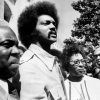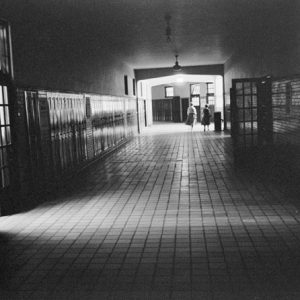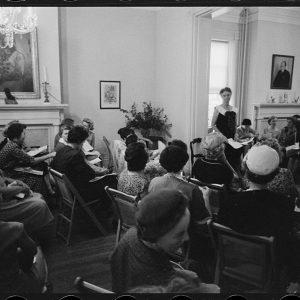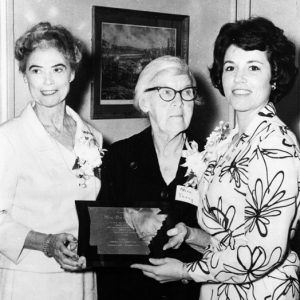calsfoundation@cals.org
Women’s Emergency Committee to Open Our Schools (WEC)
The Women’s Emergency Committee to Open Our Schools (WEC) was formed on September 12, 1958, to combat the governor’s closing of Little Rock (Pulaski County) high schools. The first meeting of the organization was held on September 16. During the summer after the 1957 desegregation crisis at Central High School in Little Rock, Governor Orval Faubus invoked a recently passed state law and closed the schools to prevent further desegregation (an act voters subsequently approved). The WEC became the first organization to publicly support reopening the schools under the district’s desegregation plan. It remained active until 1963.
Forty-eight women met in September 1958 in the antebellum home of Adolphine Fletcher Terry, the wife of former U.S. Congressman David D. Terry and a local activist for libraries, schools, and integration. The group’s initial organizers included Terry, Velma Powell (wife of Central High School’s vice principal J.O. Powell and a member of the interracial Arkansas Council on Human Relations), and Vivion Brewer (wife of Arkansas Senator Joe T. Robinson’s nephew and former aide, Joe Brewer.) Members were drawn from various civic and women’s organizations, such as the Parent Teacher Associations and the American Association of University Women; Pat House, for example, was affiliated with both groups. Because of a law passed by the Arkansas legislature targeting the membership of the NAACP, the WEC kept its membership names secret to avoid having to release them to the state’s attorney general. Immediately, the women agreed to organize a campaign in support of reopening the schools. Less than two weeks later, however, Little Rock citizens voted by a three to one margin to uphold Faubus’s action and the schools remained closed for the rest of the academic year.
WEC members continued their efforts. At their first meeting, the organization’s newly elected chairperson, Vivion Brewer, suggested contacting African American women who would be interested in working with the WEC. When several women in the audience left, the members decided to remain a segregated organization in order to deflect public criticism and keep the group intact. In spite of their efforts, the women were labeled as “integrationists,” and many of them—in particular the organization’s leaders—received hate mail and threatening phone calls as the year progressed.
After the loss of the initial election, the WEC refocused its energies, sending out flyers and purchasing newspaper advertisements in support of the schools. The members announced that they stood “neither for integration, nor for segregation, but for education,” stating that their goals were to help reopen the schools and retain all of the teachers. In November 1958, five of the six school board members resigned in frustration, and the WEC recruited new board members who would work to reopen the schools. After the elections, the school board was evenly divided between segregationist members and “moderate” ones, who supported the district’s desegregation plan.
In May 1959, after the “moderate” school board members left the regularly scheduled board meeting to prevent a quorum, the segregationist members voted to fire forty-four teachers and administrators whom they felt had supported desegregation the previous school year. The firing forced the community into action, and the organization Stop This Outrageous Purge (STOP), a group that included many of the husbands of WEC members, emerged as a local counterweight to segregationists. The WEC, with its organization already in place, also began contacting voters to support recalling the segregationist board members. Members went door-to-door, collected names for petitions, contacted voters, set up carpools to help take voters to the polls, and positioned themselves as poll watchers. When the votes came in, the three moderate members stayed on the board, while the segregationist members were removed. Little Rock’s high schools, following what became known as “the Lost Year,” reopened in August 1959.
WEC members remained vigilant against threats to public education. They watched over the state legislature and educated themselves on the political process, putting their support behind candidates who supported education. With the initial crisis over, the WEC members voted the organization out of existence in 1963, but many members continued to support education and equal opportunity individually and through other organizations, such as the Panel of American Women, whose members sought to change public opinion about desegregation through personal stories told by an integrated group of women. Through their work in the WEC, many women realized their own potential political power and worked to empower others by providing voter education seminars and actively campaigning for candidates who supported public education.
For additional information:
Brewer, Vivion. The Embattled Ladies of Little Rock, 1958–1963: The Struggle to Save Public Education at Central High. Fort Bragg, CA: Lost Coast Press, 1998.
Gates, Lorraine. “Power from the Pedestal: The Women’s Emergency Committee and the Little Rock School Crisis.” Arkansas Historical Quarterly 55 (Spring 1996): 26–57.
The Giants Wore White Gloves. DVD. Morning Star Studios, 1997.
Miller, Laura A. “Challenging the Segregationist Power Structure in Little Rock.” In Throwing Off the Cloak of Privilege: White Southern Women Activists in the Civil Rights Era. Edited by Gail S. Murray. Gainesville: University Press of Florida, 2004.
Murphy, Sara. Breaking the Silence: Little Rock’s Women’s Emergency Committee to Open Our Schools, 1958–1963. Fayetteville: University of Arkansas Press, 1997.
National Park Service
Central High School National Historic Site
 Civil Rights Movement (Twentieth Century)
Civil Rights Movement (Twentieth Century) Civil Rights and Social Change
Civil Rights and Social Change Education, Elementary and Secondary
Education, Elementary and Secondary Murphy, Sara Alderman
Murphy, Sara Alderman World War II through the Faubus Era, 1941 through 1967
World War II through the Faubus Era, 1941 through 1967 Central High School
Central High School  WEC Meeting
WEC Meeting  WEC Members Brewer, Terry, and House
WEC Members Brewer, Terry, and House 



Irene Samuels told me at a meeting for the planning of the 40th reunion of the Women’s Emergency Committee (WEC) that I was to arrange for an artwork to commemorate the contributions of the committee. She just pointed a finger at me and said that was my assignment. I was not quite sure what she had in mind, but after thinking about it for a few days, I decided to create the “windows project.” The membership of the WEC was not known to the community. And many were relieved that their names were not made public. Members of the WEC board had often suffered in their efforts to carry out the organization’s mission. Inspired by Maya Lin’s naming project, I decided to have the names of WEC members etched on the windows of the sun room, a space adjacent to the dining room of Mrs. Terry’s home, where board members had once gathered around the dining room table to conduct their business. Soos Glass Co. was hired to etch the names of WEC members, never before made public, on replacement window panes. As was usual at the time, women were identified by their husbands’ names. Only unmarried women were listed by their given names. So it was that the the membership of WEC was revealed on the occasion of the 40th anniversary of WEC. (I also served as chair of WEC’s 40th Commemoration Committee.) Hillary Clinton was the featured speaker.